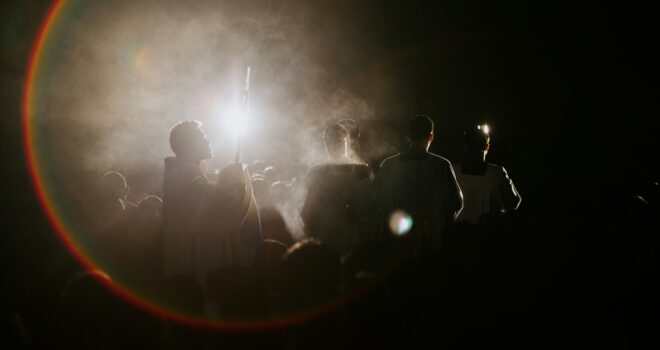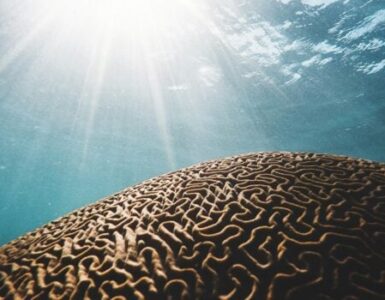Don’t be perplexed by the extra “reading” you heard before the Alleluia this Sunday. In fact, it wasn’t a reading at all. It was a Sequence: a special hymn occurring on only four Sundays during the liturgical year, one of which is the Solemnity of the Most Holy Body and Blood of Christ (the others being Easter Sunday, Pentecost, and Our Lady of Sorrows).
Saint Thomas Aquinas was commissioned by Pope Urban IV to write the Lauda Sion as the Sequence for Corpus Christi. The final stanzas of the hymn, beginning with the much more commonly known Ecce panis Angelorum (“Lo! The angel’s food is given”), constitute the “shorter form” in the current Lectionary, yet the longer form contains a simple but brilliant catechesis about what the Eucharist is, first and foremost.
Lauda Sion Salvatórem
Lauda ducem et pastórem
In hymnis and cánticis
“Zion, praise your Savior! Praise your king and shepherd with songs and hymns!”
Yes, the Eucharist is the memorial of Christ’s passion and death. Yes, it is truly His Body and Blood. Yes, it is heavenly food. But, as the Sequence reminds us, the Eucharist is, first and foremost, praise!
The Catechism of the Catholic Church lists thanks and praise as primary to our understanding of the Eucharist (cf. CCC 1358). The Holy Eucharist is par excellence an expression of gratitude for God’s creation in which the Church praises him for everything good, beautiful, and right in the world (cf. CCC 1359). The Sequence also makes clear that no praise is enough, for God is greater than any praise we can offer. Yet praise is precisely what we are created for, so we cannot help but offer it. Saint Augustine writes at the beginning of the Confessions that man wants to praise God (cf. 1.1.1.), and there is no better way to praise him than the Eucharist.
The very word signifies thanksgiving. In Greek, eucharistein (cf. Lk 22:19; 1 Cor. 11:24) and eulogein (cf. Mt 26:26; Mk. 14:22) hark back to ancient Jewish blessings most commonly said during a meal in which the participants proclaimed God’s works of creation, redemption, and sanctification (cf. CCC 1328). To adopt the right attitude in the Eucharist, however, we must acknowledge that the ultimate expression of thanks it expresses would be impossible if not for Christ (cf. CCC 1361). Any attempt to understand the Mass primarily as a human initiative or action falls miserably short.
Those fortunate enough to have heard the longer version of the Sequence on Sunday had a wonderful opportunity to reexamine their primary motive for going to Mass. Is it to fulfill a Sunday obligation? To hear a sermon? To see friends? Any of these are fine as long as they’re secondary, for the Eucharist is first and foremost a sacrifice of praise through which the Church sings God’s glory on behalf of all creation, and she is only able to do so because Christ has joined us to Himself (cf. CCC 1361).
Only after this glorious invitation to praise does that Sequence explain why the invitation is extra-special on the feast of Corpus Christi. Namely, we recall that the “living” and “vital” bread we receive was initially given to the Twelve in the Upper Room or “Cenacle.” Anyone blessed enough to have visited this traditional site of Jesus’s Last Supper knows how simple, earthy, and tactile that Passover must have been. And yet, it unalterably transformed the world and made all things new. In a poetically rich stanza of the Sequence, we sing:
Vetustátem nóvitas
Umbram fugat veritas
Noctem lux elíminat.
“Truth dispels shadow, the new the old, light blots out the night.”
Recite the stanza aloud and notice how the “old” is signified with the more rounded “u” sound in umbram (shadow) and vetustatem (oldness), and the “new” with the brighter “a” sound in novitas (newness) and veritas (truth). For whatever traces of the traditional Jewish Passover remain (and they are indeed important), Jesus, celebrating the Last Summer with His Apostles within that very context, gives it its definitive meaning: i.e., Jesus’s own “passing over” to the Father through His death and resurrection. He is the Paschal Lamb. The Last Supper both prefigures and celebrates His passion, death, and resurrection, fulfilling the Jewish Pasch and prefiguring the Church’s final Pasch in the glory of God’s kingdom (cf. CCC 1340).
The Sequence dedicates lines to describing further the kind of praise needed for this sacrament:
Sit laus plena, sit sonóra
Sit jucúnda, sit decóra
Mentis jubilátio.
“Let your praise be full, let it be loud, let it be pleasing, let the shouting of your mind be fitting.”
I’ve translated these lines literally and opted to have decora (fitting) modify iubilatio (literally a “shouting”), though it’s not entirely clear which adjectives modify laus (praise) and which iubilatio. (I am inclined to think they modify both.) Whatever the case, the Sequence obviously doesn’t want us to take praise lightly. Praising is serious business! So serious, in fact, that the Sequence, in three consecutive stanzas, warns against allowing an improper disposition of heart and mind to turn what should be a source of grace into a source of condemnation:
Sumit unus, sumunt mille:
Quantum isti, tantum ille:
Nec sumptus consúmitur.
Sumunt boni, sumunt mali:
Sorte tamen inæquáli,
Vitæ vel intéritus.
Mors est malis, vita bonis:
Vide paris sumptiónis
Quam sit dispar éxitus.
“One partakes, a thousand partake; however much the thousand, so the one. Nor is Jesus, having been partaken, consumed. Both the good and bad partake, but with different results, for the former receive life, the latter death; death to the evil, life to the good. See what a different outcome the same partaking has for each!”
There’s no use in trying to sugarcoat these verses. If you were fortunate enough to hear them, I imagine it was difficult to cut through archaic and convoluted English of the current Lectionary. Be that as it may, rejoice! You cannot find a better reason to go to Confession! Allow the Lord to forgive your sins, heal your soul, ease your conscience, and prepare you again next week for a celebration greater than you can ever imagine.
Lauda, Sion!
Photo by Jacob Bentzinger on Unsplash










